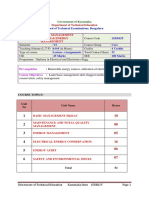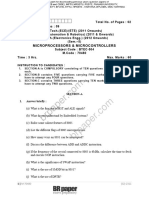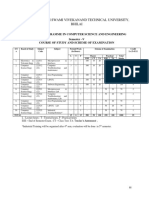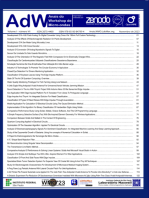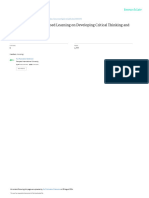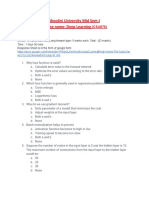3C.Embedded Systems-1
Uploaded by
jeelankhader13C.Embedded Systems-1
Uploaded by
jeelankhader1Government of Karnataka
Department of Technical Education
Board of Technical Examinations, Bengaluru
Course Title: EMBEDDED SYSTEMS Course Code : 15EE63C
Semester : VI Course Group : Core
Teaching Scheme (L:T:P) :4:0:0 (in Hours) Credits : 4 Credits
Type of course :Lecture +Assignments Total Contact Hours : 52
CIE : 25 Marks SEE : 100 Marks
Programme: Diploma in Electrical and Electronics Engg.
Pre-requisites : Knowledge on Mathematics, Electrical Engg, Analog and Digital
electronics and C language, Electrical machines, Power electronics,
E and E Measurements.
Course Objectives : To understand the architecture of 8051, instruction set,
programming and interfacing
COURSE TOPICS:
Unit
Unit Name Hours
No
1 Introduction to 8051 Microcontroller 06
2 8051 Architecture 09
3 8051 Instruction Set 09
4 8051Assembly and C Programming 07
8051 Timers, Serial port and Interrupt
5 11
Programming
6 8051 Interfacing and Peripherals 10
Total 52
Directorate of Technical Education Karnataka State 15EE63C Page 1
Course Outcomes:
On successful completion of the course, the student will be able to:
1. Acquire knowledge on Microcontrollers and 8051 pin descriptions.
2. Explain 8051 architecture
3. Understand various instructions of 8051.
4. Develop simple programs for 8051 in assembly and C language.
5. Write programs on Counter and Timer of 8051, programs for serial communication
and interrupts of 8051.
6. Design simple circuits for interfacing various peripherals with 8051.
Composition of Educational Components
Questions for CIE and SEE will be designed to evaluate the various educational components
(Bloom’s Taxonomy) such as:
Sl. Weightage (%) Total Marks
Educational Component
No. (Out of 145)
1 Remembering 10 20
2 Understanding 50 75
3 Application/ Analysis 40 50
Total 100 145
Directorate of Technical Education Karnataka State 15EE63C Page 2
Course Outcome linkage to Cognitive Level
Cognitive Level Legend: R- Remember, U- Understand, A- Application
CL Linked Teaching Hrs
Course Outcome PO
Acquire knowledge on
CO1 Microcontrollers and8051 pin R/U 2, 8,10 06
descriptions.
Explain 8051 architecture 2,8, 10 09
CO2 R/U
Understand various instructions of
CO3 R/U 2,8, 10 09
8051
Develop simple programs for 8051 in 2,3,4,5,7,8,
CO4 A 07
assembly and C language 9,10
Write Counter / Timer programs,
programs for serial communication 2,3,4,5,7,8,
C05 U/A 11
and interrupts of 8051. 9,10
Design the simple circuits for
2,3,4,5,7,8,
C06 interfacing various peripherals with R/U/A 10
9,10
8051
Total sessions 52
Directorate of Technical Education Karnataka State 15EE63C Page 3
Course Content and Blue Print of Marks for SEE:
Questio Questions
ns to be to be set
5 10
Max. set for for
Mar Mar Marks
Mar (5marks (10marks)
Un R/U/ Ho ks ks Weighta
Unit Name ks )
it A ur Qns. Qns. ge
per PART - PART - B
(%)
Unit A
Part Part R U A R U A
A B
Introducti
on to 8051
1 R/U 6 15 1 1 1 0 0 1 0 10
Microcontro
ller
8051
2 R/U 9 25 1 2 1 0 0 2 0 17
Architecture
8051
3 Instruction R/U 9 25 2 1.5 1 1 0.5 1 0 17
Set
8051
Assembly
4 and C A 7 20 1 1.5 0 0 1 0 1.5 14
Programmin
g
8051
Timers,
Serial port
5 and U/A 11 30 2 2 0 1 1 0 1 1 21
Interrupt
Programmin
g
8051
Interfacing R/U/
6 10 30 2 2 1 1 1 1 21
and A
Peripherals
9 10
TOTAL 52 145 9 10 (45 (100
Marks) Marks)
Directorate of Technical Education Karnataka State 15EE63C Page 4
Course-PO Attainment Matrix
Programme Outcomes
Course
1 2 3 4 5 6 7 8 9 10
EMBEDDED
1 3 3 3 3 0 3 3 3 3
SYSTEMS
Level 3- Highly Addressed, Level 2-Moderately Addressed, Level 1-Low Addressed.
Method is to relate the level of PO with the number of hours devoted to the COs which address the given PO.
If >40% of classroom sessions addressing a particular PO, it is considered that PO is addressed at Level 3
If 25 to 40% of classroom sessions addressing a particular PO, it is considered that PO is addressed at Level 2
If 5 to 25% of classroom sessions addressing a particular PO, it is considered that PO is addressed at Level 1
If < 5% of classroom sessions addressing a particular PO, it is considered that PO is considered not-addressed.
Directorate of Technical Education Karnataka State 15EE63C Page 5
Course Content:
Unit –I
Introduction to 8051 Microcontroller (6 Hrs)
Introduction to microcontrollers, applications, comparison between microprocessor and micro
controller, block diagram of 8051,features of 8051,Pin diagram of 8051,Pin description of
8051, I/O ports Pins and their functions, structure of Assembly language program.
Unit –II
8051 Architecture (9 Hrs)
Registers, On chip 8051 chip ROM memory address range, 8051 data type and directives,
register banks, On-chip ROM memory and RAM Memory organization, stack and stack
pointer, SFR registers, I/O ports structure and operation bit address. Registers - A, B, SP,
DPTR, PC and SFRs. General Format and functions of each bit of PSW SFRs, machine
cycle, Time delay calculations.
Unit –III
8051 Instruction Set (9 Hrs)
Arithmetic instructions, Addressing modes ,Data transfer instructions, Logical and compare
instructions, Jump and Loop, Rotate and swap instructions, Branch instructions, Bit
manipulation instructions, Stack and Subroutine instructions.
Unit –IV
8051Assembly and C Programming (7 Hrs)
Programs on Loop and Jump instructions, call instructions, arithmetic and logic
instructions, Compare instruction, Rotate and Swap instructions, BCD and ASCII
conversion vice-versa programs, Bit manipulation programs.
8051 programming using C – Advantage of using C. Data types. Simple programs based on
arithmetic, logical, branching, bit manipulation, rotate and swap instructions.
Unit –V
8051 Timers, Serial port and Interrupt Programming (11 Hrs)
Timers of 8051 and their associated Registers, General format and function of each bit of
TMOD, TCON, Modes of operation of timers, programs on timers and counters in
assembly language.
Basics of serial communication, SBUF SFR, pin description of 9 pin RS232 connector, Pin
description of Max233, 8051 connection to RS232 using Max233, Baud rate and its
calculation, General format and function of each bit of SCON,PCON SFR’s, Programs on
serial communication in assembly language.
Interrupts versus polling, Interrupt service routine (ISR) Interrupts with vector table,
General format and function of each bit of IE,IP SFR, Programs on interrupts in assembly
language.
Directorate of Technical Education Karnataka State 15EE63C Page 6
Unit –VI
8051 Interfacing and Peripherals (10 Hrs)
Interfacing an LCD and LED to 8051, 8051 interfacing with Hex keyboard, ADC, DAC
and sensor interfacing, Interfacing DC motor, Stepper motor, Relay, Opto isolator and
RTC.(Only circuit diagrams and explanation)
Text Book:
1.Muhammad Ali Mazidi,Janice GillispieMazidi and Rolin D McKinlay “ THE 8051
MICROCONTROLLER AND EMBEDDED SYSTEMS Using Assembly
and C”.Pearson Second edition.
Reference Books:
1. The 8051 Microcontrollers-II edition-Kenneth j Ayala. Perram Publications.
2. Embedded system Design-Frank Vahid /Tony Givargis WSE. Wiley
Publications.
3. 8051 Microcontroller-Hardware,Software and applications-V
Udayashankara/M S mallikarjunaswamy-Tata McGraw Hill
4. Programming and Customizing the 8051 Microcontroller-MykePredko-Tata
McGraw Hill
5. Intel 8 bit Embedded controller Handbook-Intel
6. Programming Embedded systems in C and C++ - Michael Barr –O’Reilly
7. 8051 Microcontroller – Uma S.Rao
e-Resources:
1)YouTube videos on interfacing various peripherals and devices
2)www.microdigital.com
Directorate of Technical Education Karnataka State 15EE63C Page 7
Course Delivery:
The Course will be delivered through lectures, classroom interaction, animations, group
discussion, exercises and student activities, assignments.
Course Assessment and Evaluation:
Course
To Max Evidence
What Frequency Outcom
Whom Marks Collected
es
Three IA tests
for Theory:
CIE (Average Blue
I A Tests 20 1 to 6
(Conti marks of Three Books
nuous Tests to be
Student computed).
Interna
s
l Student Report of
Dire Evalua 05 1 to 6
ct Student Activity 3 pages
tion) Activity
Asse
ssme TOTAL 25
nt
SEE
(Semes
Answer
ter Stud End Of the
End Exam 100 Scripts at 1 to 6
End ents Course
BTE
Exami
nation)
Indi Student Feedback on Middle Of
Feed Back Forms 1 to 6
rect course The Course
Stud
Asse
ents
ssme End Of The
End Of Course Survey Questionnaires 1 to 6
nt Course
*CIE – Continuous Internal Evaluation *SEE – Semester End Examination
Note: I.A. test shall be conducted for 20 marks. Average marks of three tests shall be
rounded off to the next higher digit.
Directorate of Technical Education Karnataka State 15EE63C Page 8
Course Contents with Lecture Schedule:
Lesson No./ Duration
Contents
Session No.
Unit I Introduction to 8051 Microcontroller 6 Hours
1. Introduction to microcontrollers and their applications 01 Hour
comparison between microprocessor and micro controller and 01 Hour
2.
block diagram of 8051
3. features of 8051 and Pin diagram of 8051 01 Hour
Pin description of 8051 01 Hour
4.
5. I/O ports Pins and their functions. 01 Hour
6. structure of Assembly language program 01 hour
9 Hours
Unit II 8051 Architecture
Explain A, B, SP, DPTR, 01 Hour
7.
8. Explain PCSFRs, Register banks 01 Hour
9. General format and functions of each bit of PSW SFRs. 01 Hour
10. On chip RAM Memory organization 01 Hour
11. stack and stack pointer 01 Hour
8051 data type and directives 01 Hour
12.
13. I/O ports structure and operation 01 Hour
On chip 8051 chip ROM memory address range 01 Hour
14.
machine cycle, Time delay calculations 01 Hour
15.
Unit III 8051 INSTRUCTION SET 9Hr
Explain the various addressing modes of 8051 with examples 01 Hour
16.
Explain ADD, ADDC, SUBB- instructions with examples 01 Hour
17.
Explain MUL,DIV,DA INC,DEC instructions with examples 01 Hour
18.
19. Explain the data transfer instructions MOV, MOVX 01 Hour
20. Logical instructions – AND,OR, XOR ,CPL 01 Hour
Directorate of Technical Education Karnataka State 15EE63C Page 9
21 Compare instructions – CJNE, DJNZ 01 hour
22 01 Hour
Rotate and swap instructions – RR, RL, RRC, RLC, SWAP
23 01 Hour
Jump – LJMP,SJMP, Bit manipulation instructions
24 Stack and Subroutine instructions – PUSH, POP, LCALL,
01 Hour
ACALL, RET
07 Hour
UNIT IV 8051Assembly and C Programming
25 01 Hour
Programs on Loop and Jump instructions, call instructions
26 Programs on Arithmetic instructions Unsigned Addition, 01 Hour
Subtraction, Multiplication, Division
27
Signed number arithmetic and arithmetic operations 01 Hour
28 Programs on Logical and compare instructions 01 Hour
29 Rotate Swap, BCD to ASCII conversion and single bit 01 Hour
instructions.
30 8051 programming using C – Advantage of using C. Data types 01 Hour
31 Simple programs based on arithmetic, logical, branching, bit
01 Hour
manipulation, rotate and swap instructions
Unit V 8051 Timers, Serial port and Interrupt Programming 11 Hr
32 Timers of 8051 and their associated Registers TMOD, TCON 01 Hour
format
33 Modes of operation of timers and programs on timers in
01 Hour
assembly language
34 Programming counters in assembly language 01 Hour
35 01 Hour
Basics of serial communication, SBUF SFR
36 Pin description of 9 pin RS232 connector, Pin description of
01 Hour
Max233, 8051 connection to RS232 using Max233
37 Baud rate and its calculation, General format and function of
01 Hour
each bit of SCON,PCON SFR’s
38 Programs on serial communication in assembly language.
01 Hour
39 Interrupts versus polling, ISR, Interrupts with vector table 01 Hour
Directorate of Technical Education Karnataka State 15EE63C Page 10
40 General format and function of each bit of IE,IP SFR 01 Hour
41 Programming Timer and External hardware interrupts 01 Hour
42 Programming Serial communication interrupt and Interrupt
01 Hour
priority in 8051
Unit VI 8051 Interfacing and Peripherals 10Hr
43 01 Hour
Interfacing an LCD to 8051 and explain
44 Interfacing a LED to 8051 and explain 01 Hour
45 01 Hour
8051 interfacing to the keyboard with explanation
46 ADC interfacing to 8051 and explain 01 Hour
47 Sensor(temperature) LM35 interfacing to 8051 and explain 01 Hour
48 8051 to DAC interfacing and explain 01 Hour
49 Explain RTC DS12887 and interface it to 8051 01 Hour
50 Relay and Opto isolator interfacing to 8051 and explain 01 Hour
51 Interface stepper motor to 8051 and explain 01 Hour
52 Interface DC motor to 8051 and explain 01 Hour
Directorate of Technical Education Karnataka State 15EE63C Page 11
Student Activity (any one to be submitted with 3 pages self HAND WRITTEN report):
1. Draw an Elevator interface circuit with 8051 with assemble language/ C program and
execute on 8051 kit
2. Draw an LCD interface circuit with 8051 with assemble language/ C program and
execute on 8051 kit
3. Draw an LED interface circuit with 8051 with assemble language/ C program and
execute on 8051 kit
4. Draw an Hexkey board interface circuit with 8051 with assemble language/ C program
and execute on 8051 kit
5. Draw an ADC interface circuit with 8051 with assemble language/ C program and
execute on 8051 kit
6. Draw an DAC interface circuit with 8051 with assemble language/ C program and
execute on 8051 kit
7. Draw an DC MOTOR interface circuit with 8051 with assemble language/ C program
and execute on 8051 kit
8. Draw an STEPPER MOTOR interface circuit with 8051 with assemble language/ C
program and execute on 8051 kit
9. Draw and SENSOR interface circuit with 8051 with assemble language/ C program
and execute on 8051 kit
10. Draw an OPTO ISOLATOR interface circuit with 8051 with assemble language/ C
program and execute on 8051 kit
11. Draw an RTC interface circuit with 8051 with assemble language/ C program and
execute on 8051 kit
12. Draw an RELAY interface circuit with 8051 with assemble language/ C program and
execute on 8051 kit
Directorate of Technical Education Karnataka State 15EE63C Page 12
Directorate of Technical Education Karnataka State 15EE63C Page 13
MODEL QUESTION PAPER (CIE)
Test/Date and Time Semester/year Course/Course Code Max Marks
1stIATest/ 6 th week, V SEM, E & E Engg Embedded Systems
20
9 Aug 16, 9-10 AM Year: 2015-16 Course code:15EE63C
Name of Course coordinator :
Units Covered :1 and 2
Course Outcomes : 1 and 2
Instruction :(1). Answer all questions (2). Each question carries five marks
Question
Question CL CO PO
No.
1 List the applications of microcontrollers R 1 2, 10
2 List any five features of 8051. R 1 2, 10
OR
Compare microprocessor and microcontrollers U
3 Explain PSW SFR. U 2 2, 10
Or
Explain the structure of Port 0. U
4 Explain the internal RAM organization of 8051 A 2 2, 10
CL: Cognitive Level, R-Remember, U-Understand, A-Application, PO: Program Outcomes
Directorate of Technical Education Karnataka State 15EE63C Page 14
Model QUESTION Paper BANK:
Course Title: EMBEDDED SYSTEMS Course Code: 15EE63C
CO1- Acquire knowledge on Microcontrollers and 8051 pin descriptions.
Unit 1 –Introduction to 8051 Microcontroller
Cognitive Level: REMEMBER
1) State the concept of microcontroller.
2) List the applications of Microcontrollers.
3) List the features of 8051 microcontroller.
4) Draw the block diagram of 8051.
5) Draw the pin diagram of 8051.
Cognitive Level: UNDERSTAND
6) Compare between microprocessor and micro controller with block diagram.
7) Describe the function of each pin of 8051.
8) Draw the block diagram of 8051 and explain.
9) Explain the structure and function of Port 0.
10) Explain the structure and function of Port 1.
11) Explain the structure and function of Port 2.
12) Explain the structure and function of Port 3.
13) Explain the structure and function of Port 0 and port 1.
14) Explain the structure and function of Port 1 and port 2.
15) Explain the structure and function of Port 2 and port 3.
16) Explain the structure of assembly language program.
CO2- Describe 8051 architecture
Unit 2 –8051 ARCHITECTURE
Cognitive Level: REMEMBER
17) Explain Program counter and data pointer.
18) Explain the 8051 data types and directives.
19) Briefly explain A and B registers.
20) Explain briefly the organization of internal ROM.
21) Explain briefly stack and stack pointer.
Directorate of Technical Education Karnataka State 15EE63C Page 15
Cognitive Level: UNDERSTAND
22) Draw the PSW SFR and explain the function of each bit.
23) Draw and explain the internal RAM organisation.
24) Explain the special function registers with their internal RAM address.
25) Explain alternate functions of Port 0 pins
26) Explain alternate functions of Port 2 pins
27) Explain alternate functions of Port 3 pins
28) Explain stack operation in 8051.
29) Explain 8051 timing and delay calculations.
30) Explain machine cycle for the 8051.
31) Calculate the period of the machine cycle foe 8051 with a crystal frequency of (i)
11.0592 MHz,(ii) 16 MHz(iii) 20Mhz
CO3- Identify various instructions of 8051.
Unit 3 -8051 INSTRUCTION SET
Cognitive Level: REMEMBER
32) List the addressing modes.
33) List the data transfer and exchange instructions.
34) List the arithmetic instructions of 8051.
35) List the logical instructions of 8051.
36) Tabulate jump and call instructions.
37) List the types of rotate instructions.
38) Tabulate single bit instructions.
39) List the four arithmetic flags.
Cognitive Level: UNDERSTAND
40) Explain immediate addressing mode with examples.
41) Explain register addressing mode with examples.
42) Explain direct addressing mode with examples.
43) Explain indirect addressing mode with examples.
44) Explain indexed addressing mode with examples
45) Explain PUSH and POP instructions with examples.
46) Explain the opcode, operation and one example of exchange instruction.
47) Explain the increment and decrement opcodes and their operation.
48) Explain the different ADD opcodes and their operations.
49) Explain ADDC opcode and its operation with example.
50) Explain SUBB opcode and its operation with an example.
51) Write the multiplication opcode syntax and its operation with example.
Directorate of Technical Education Karnataka State 15EE63C Page 16
52) Write the division opcode syntax and its operation with example.
53) Explain DA instruction with example.
54) Explain AND logic instruction with an example.
55) Explain OR logic instruction with an example
56) Explain XOR logic instruction with an example.
57) Explain CPL logic instruction with an example.
58) Explain RR and RL instructions with examples.
59) Explain RRC and RLC instructions with examples
60) Explain SWAP instruction with an example.
61) Explain LJMP and SJMP instructions with examples
62) Explain LCALL and ACALL instructions with examples
63) Explain RET and RETI instructions.
CO4- Develop simple programs for 8051 in assembly and C language.
Unit 4 - 8051Assembly and C Programming
Cognitive Level: APPLICATION
64) Write a program to multiply 25 by 10 using repeated addition.
65) Write a program to add the first 20 natural numbers.
66) Write a program to load the accumulator with the value AAH and compliment the
ACC 700 times.
67) Write a program to toggle the bits of port 1 with a delay which depends on the value
in R0.
68) Write a program to create a square wave of 50% duty cycle on bit 0 of port1.
69) Write a program to create a square wave of 66% duty cycle on bit 0 of port1
70) Write a program to a)keep monitoring pin p0.1 until it becomes high b)when P0.1
becomes high, read in the data from port1 c)send a low-to-high pulse P0.2 to
indicate that the data has been read.
71) A switch is connected to pin P1.0 and an LED to pin P2.7. Write a program to get the
status of the switch and send it to LED.
72) Write a program to copy the value 55H into RAM memory locations 40H to 44H
using direct addressing mode.
73) Write a program to copy the value 55H into RAM memory locations 40H to 44H
using register indirect addressing mode without loop
74) Write a program to copy the value 55H into RAM memory locations 40H to 44H
using register indirect addressing mode with a loop.
75) Write a program to clear 16RAM locations starting at RAM address 60H.
76) Write a program to take 10 bytes of data from RAM locations 45H to 54H, add 02 to
each of them and save the result in the RAM locations 79H down to 70H.
77) Write a program to see if the RAM location37H contains an even value. If so, send it
to P2. If not, make it even and then send it to P2.
Directorate of Technical Education Karnataka State 15EE63C Page 17
78) Write a program to add numbers stored in RAM locations 40 -40H and store the
result in register A(lower byte) and R7(higher byte).
79) Write a program to add two 16 bit numbers FC45H and 02ECH.
80) Assume that 5 BCD numbers are stored in RAM location starting from 40H. Write a
program to add the numbers and store the result in BCD.
81) In a semester, a student has to take six courses. The marks of the student(out of 25)
are stored in RAM locations47H onwards. Find the average marks, and output it on
port 1.
82) Ten hex numbers are stored in RAM locations 50H onwards. Write a program to find
biggest number in the set. The biggest number should finally be saved in 60H.
83) Write a program to transfer value 41H serially via pin P2.1. Put two high’s at the start
and end of the data. Send the byte LSB first.
84) Assume the register A has a packed BCD. Write a program to convert packed BCD
to two ASCII numbers and place them in R2 and R6.
85) Write an 8051 C program to get a byte of data from P1, wait half sec and then send it
to P2.
86) Write an 8051 C program to toggle all the bits of P0 and P2 continuously with 250ms
delay. Use the inverting operator.
87) Write 8051 C program to convert ASCII digits of ‘4’and ‘7’ to packed BCD and
display them on P1.
CO5-Write programs using Counter and Timer of 8051, programs for serial
communication and interrupts of 8051.
Unit 5 –8051 Timers, Serial port and Interrupt Programming
Cognitive Level: UNDERSTAND
88) Draw the general format and function of each bit of TMOD SFR.
89) Draw the general format and function of each bit of TCON SFR.
90) List the different operating modes of timers in 8051.
91) Draw a diagram showing 8051 connection to RS232 using Max233
92) Explain SBUF register
93) Draw the general format and function of each bit of SCON SFR.
94) Draw the general format and function of each bit of PCON SFR
95) List the different modes of serial transmission.
96) List the interrupts and their destination according to hierarchy upon reset.
97) Differentiate interrupts and polling
98) Draw the IE SFR and explain the function of each bit
99) Draw the IP SFR and explain the function of each bit
100) Define ISR
Directorate of Technical Education Karnataka State 15EE63C Page 18
Cognitive Level: APPLICATION
101) Explain briefly different modes of timer with diagram.
102) Explain the operation of timer in Mode 1.
103) Explain the operation of timer in Mode 2.
104) List the steps to program timer in mode 1.
105) List the steps to program timer in mode 2
106) Write a program to create a square wave of 50% duty cycle on P1.5 use timer0 in
mode1 to generate the delay.
107) Write a program to a toggle the pin P2.5 continuously every 250 msec a use timer 0
in mode 2
108) Assume the 1HZ external clock is being fed to pin T1 write a program for counter 1
in mode 2 to count up and display the state of TL1 count on P1.
109) Sketch the RS232DB9 connector and tabulate function of each pin.
110) Sketch the MAX233 connector and tabulate function of each pin
111) List the steps to program 8051 to transfer data serially
112) List the steps to program 8051 to receive data serially
113) Write a program to transfer letter ’Y’ serially at 9600 baud rate continuously.
114) Write a program to receive data serially and send it out to port 0 in parallel also save
the data at 60H RAM location.
115) Explain six interrupts in 8051.
116) Write a program to get single bit of data from P1.7 and send it to P1.0 while
simultaneously creating a square wave of 200µsec on pin 2.5 using interrupts.
CO6- Design simple circuits for interfacing various peripherals with 8051.
Unit 6 - 8051 Interfacing and Peripherals
Cognitive Level: REMEMBER
117) Explain the pin description of LCD
118) Explain step angle
119) Tabulate the resolution and step size of ADC
Cognitive Level: UNDERSTAND
120) Draw the ADC0804in free running mode and explain the function of each pin
121) Explain the stepper motor with the diagrams of rotor alignment and stator winding
configuration
122) Draw the pin diagram of DS12887 RTC and explain briefly the function of each pin.
123) Sketch the diagram of LCD interface to 8051
124) Draw the 8051 connection to ADC0804 with self clock
125) Draw the matrix key board connection to 8051
126) Draw the diagram to interface LM35 temperature sensor to the 8051
127) Draw the diagram to interface stepper motor to the 8051
Directorate of Technical Education Karnataka State 15EE63C Page 19
128) Draw a circuit showing dc motor connection to 8051 through transistor, optoisolator
and switch
129) Draw an interface of DS12887(RTC) to 8051
130) Draw the relay connection to an8051.
Cognitive Level: APPLICATION
131) Sketch and explain the diagram of LCD interface to 8051
132) Draw the matrix key board connection to 8051 and explain briefly about scanning
and identifying the key.
133) Draw and explain the 8051 connection to ADC0804 with self clock
134) Explain the concept of 8051 connection to DAC0808 with diagram
135) Explain, with diagram the interface of LM35 temperature sensor to the 8051
136) Explain, with diagram the interface of stepper motor to the 8051
137) Draw and explain a circuit showing dc motor connection to 8051 through transistor,
opto isolator and switch
138) Explain, with circuit diagram, interfacing opto isolator to the 8051 microcontroller
139) Explain the relay connection to a 8051 with a diagram
140) Draw and explain an interface of DS12887(RTC) to 8051
Directorate of Technical Education Karnataka State 15EE63C Page 20
Model Question Paper:
Code:15EE54C
EMBEDDED SYSTEMS
VI Semester Examination
Diploma in Electrical and Electronics Engg.
Time: 3 Hours
Max Marks: 100
Note: i) Answer any SIX questions from PART - A. Each question caries 5 marks.
ii) Answer any SEVEN Questions from PART - B. Each question caries 10 marks.
PART – A
1) List the features of 8051 microcontroller
2) Explain briefly stack and stack pointer.
3) List the addressing modes.
4) Explain RRC and RLC instructions with examples
5) Write a program to multiply 25 by 10 using repeated addition
6) Draw the general format and function of each bit of SCON SFR.
7) Draw the 8051 connection to ADC0804 with self clock
8) Draw the pin diagram of DS12887 RTC
9) List the steps to program timer in mode 1.
PART – B
10) (a) Describe the function of any 5 pins of 8051 (5M)
(b) Explain the structure and function of Port 0 . (5M)
11) (a) Draw and explain the internal RAM organisation. (10M)
12) (a) Draw the PSW SFR and explain the function of each bit. (7 M)
(b) Explain machine cycle for the 8051. (3 M)
13) (a) Explain indirect addressing mode with examples (4 M)
(b) Explain ADD and XRL instructions with examples (6 M)
14) (a) List the data transfer and exchange instructions . (3 M)
(b) Write a program to create a square wave of 50% duty cycle on bit 0 of (6 M)
port1.
15) (a) Write a program to add two 16 bit numbers FC45H and 02ECH (3 M)
(b) Write a 8051 C program to toggle all the bits of P0 and P2 continuously (7 M)
with 250ms delay. Use the inverting operator.
16) (a) Draw the IE SFR and explain the function of each bit (7 M)
(b) Explain SBUF register (3 M)
17) (a) Draw the ADC0804in free running mode and explain the function of each (10M)
pin
Directorate of Technical Education Karnataka State 15EE63C Page 21
18) (a) List six interrupts in 8051. (3 M)
(b) Write a program to receive data serially and send it out to port 0 in (7M)
parallel also save the data at 60H RAM location
19) (a) Explain, with diagram the interface of stepper motor to the 8051 (5 M)
(b) Explain, with diagram the interface of LM35 temperature sensor to the (5M)
8051
---- XXX ------
Directorate of Technical Education Karnataka State 15EE63C Page 22
You might also like
- PLC Controls with Structured Text (ST): IEC 61131-3 and best practice ST programmingFrom EverandPLC Controls with Structured Text (ST): IEC 61131-3 and best practice ST programming4/5 (12)
- 50 Questions For Finding Your Passion Purpose in Life PDF100% (1)50 Questions For Finding Your Passion Purpose in Life PDF12 pages
- Transmision Distribution and UtilisationNo ratings yetTransmision Distribution and Utilisation24 pages
- Analog Electronics: Board of Technical Examinations, BengaluruNo ratings yetAnalog Electronics: Board of Technical Examinations, Bengaluru18 pages
- Industrial Drives and Control VI: Department of Technical EducationNo ratings yetIndustrial Drives and Control VI: Department of Technical Education22 pages
- Gujarat Technological University: Page 1 of 5No ratings yetGujarat Technological University: Page 1 of 55 pages
- EC8691-Microprocessor and Microcontroller Department of IT 2021-2022No ratings yetEC8691-Microprocessor and Microcontroller Department of IT 2021-202224 pages
- Automotive Electrical and Elctronics SystemsNo ratings yetAutomotive Electrical and Elctronics Systems15 pages
- Microcontroller Weightage Revised 2019-20No ratings yetMicrocontroller Weightage Revised 2019-204 pages
- 3.concepts of Electrical & Electronics EnggNo ratings yet3.concepts of Electrical & Electronics Engg15 pages
- Course Outcome CL: Board of Technical Examinations, BangaloreNo ratings yetCourse Outcome CL: Board of Technical Examinations, Bangalore13 pages
- Rat206 - Microcontrollers and Embedded Systems - Ra - 13-03-2024-F - Set ANo ratings yetRat206 - Microcontrollers and Embedded Systems - Ra - 13-03-2024-F - Set A1 page
- Microcontroller Lab - RB - For CirculationNo ratings yetMicrocontroller Lab - RB - For Circulation36 pages
- Microcontroller Lab - RB - For CirculationNo ratings yetMicrocontroller Lab - RB - For Circulation36 pages
- Analog and Digital Lab: Course OutcomesNo ratings yetAnalog and Digital Lab: Course Outcomes12 pages
- Gujarat Technological University Electronics (10), Electronics & Communication (11), Electronics & Telecommunication EngineeringNo ratings yetGujarat Technological University Electronics (10), Electronics & Communication (11), Electronics & Telecommunication Engineering3 pages
- 314008-COMPUTER AIDED DRAWING AND SIMULATIONNo ratings yet314008-COMPUTER AIDED DRAWING AND SIMULATION8 pages
- Gujarat Technological University: Microprocessor and Microcontroller Interfacing 2150907 B.E. 5 SemesterNo ratings yetGujarat Technological University: Microprocessor and Microcontroller Interfacing 2150907 B.E. 5 Semester4 pages
- ECL 202 Analog Circuits and Simulation Lab: Course Information & Course Plan50% (2)ECL 202 Analog Circuits and Simulation Lab: Course Information & Course Plan10 pages
- SESSION: 2016 - 2017 (Spring) B. Tech. 3 Year Subject Code: EE 342 Subject Name: No. of Pages: 1 (Both Side) Full Marks: 30 Duration: 2 HoursNo ratings yetSESSION: 2016 - 2017 (Spring) B. Tech. 3 Year Subject Code: EE 342 Subject Name: No. of Pages: 1 (Both Side) Full Marks: 30 Duration: 2 Hours2 pages
- Government Polytechnic, Nagpur. Course Curriculum: Teaching SchemeNo ratings yetGovernment Polytechnic, Nagpur. Course Curriculum: Teaching Scheme41 pages
- Fakulteti Juridik: Universiteti I Prishtinës "Hasan Prishtina"No ratings yetFakulteti Juridik: Universiteti I Prishtinës "Hasan Prishtina"2 pages
- Research Paper in Writing in The DisciplineNo ratings yetResearch Paper in Writing in The Discipline14 pages
- COT DLP FILIPINO6 - ROMA-Wastong Paggamit NG Pang-Angkop at Pangatnig FINALNo ratings yetCOT DLP FILIPINO6 - ROMA-Wastong Paggamit NG Pang-Angkop at Pangatnig FINAL25 pages
- Medical Consultant Interview Question by ISC Medical Leaders in Medical IntervNo ratings yetMedical Consultant Interview Question by ISC Medical Leaders in Medical Interv33 pages
- LABREPORT1 IS216 Ramos Samuya Sison Yadao TumambingNo ratings yetLABREPORT1 IS216 Ramos Samuya Sison Yadao Tumambing6 pages
- UTS Final3 Taking Charge of Ones Health 2024No ratings yetUTS Final3 Taking Charge of Ones Health 202457 pages
- Majid Majeed Akbar: Objective: Professional ExperienceNo ratings yetMajid Majeed Akbar: Objective: Professional Experience5 pages
- Learn Project Management For FREE With GOOGLENo ratings yetLearn Project Management For FREE With GOOGLE3 pages
- 2 Sample For Applying Computer Certificate by EmailNo ratings yet2 Sample For Applying Computer Certificate by Email6 pages
- Plan of Action in Practical Research 1 For Teacher AdvisersNo ratings yetPlan of Action in Practical Research 1 For Teacher Advisers1 page
- Elementary Memory Book Endoftheyear Freebie100% (1)Elementary Memory Book Endoftheyear Freebie30 pages
- PLC Controls with Structured Text (ST): IEC 61131-3 and best practice ST programmingFrom EverandPLC Controls with Structured Text (ST): IEC 61131-3 and best practice ST programming
- 50 Questions For Finding Your Passion Purpose in Life PDF50 Questions For Finding Your Passion Purpose in Life PDF
- Analog Electronics: Board of Technical Examinations, BengaluruAnalog Electronics: Board of Technical Examinations, Bengaluru
- Industrial Drives and Control VI: Department of Technical EducationIndustrial Drives and Control VI: Department of Technical Education
- EC8691-Microprocessor and Microcontroller Department of IT 2021-2022EC8691-Microprocessor and Microcontroller Department of IT 2021-2022
- Course Outcome CL: Board of Technical Examinations, BangaloreCourse Outcome CL: Board of Technical Examinations, Bangalore
- Rat206 - Microcontrollers and Embedded Systems - Ra - 13-03-2024-F - Set ARat206 - Microcontrollers and Embedded Systems - Ra - 13-03-2024-F - Set A
- Gujarat Technological University Electronics (10), Electronics & Communication (11), Electronics & Telecommunication EngineeringGujarat Technological University Electronics (10), Electronics & Communication (11), Electronics & Telecommunication Engineering
- Gujarat Technological University: Microprocessor and Microcontroller Interfacing 2150907 B.E. 5 SemesterGujarat Technological University: Microprocessor and Microcontroller Interfacing 2150907 B.E. 5 Semester
- ECL 202 Analog Circuits and Simulation Lab: Course Information & Course PlanECL 202 Analog Circuits and Simulation Lab: Course Information & Course Plan
- SESSION: 2016 - 2017 (Spring) B. Tech. 3 Year Subject Code: EE 342 Subject Name: No. of Pages: 1 (Both Side) Full Marks: 30 Duration: 2 HoursSESSION: 2016 - 2017 (Spring) B. Tech. 3 Year Subject Code: EE 342 Subject Name: No. of Pages: 1 (Both Side) Full Marks: 30 Duration: 2 Hours
- Government Polytechnic, Nagpur. Course Curriculum: Teaching SchemeGovernment Polytechnic, Nagpur. Course Curriculum: Teaching Scheme
- Fakulteti Juridik: Universiteti I Prishtinës "Hasan Prishtina"Fakulteti Juridik: Universiteti I Prishtinës "Hasan Prishtina"
- COT DLP FILIPINO6 - ROMA-Wastong Paggamit NG Pang-Angkop at Pangatnig FINALCOT DLP FILIPINO6 - ROMA-Wastong Paggamit NG Pang-Angkop at Pangatnig FINAL
- Medical Consultant Interview Question by ISC Medical Leaders in Medical IntervMedical Consultant Interview Question by ISC Medical Leaders in Medical Interv
- LABREPORT1 IS216 Ramos Samuya Sison Yadao TumambingLABREPORT1 IS216 Ramos Samuya Sison Yadao Tumambing
- Majid Majeed Akbar: Objective: Professional ExperienceMajid Majeed Akbar: Objective: Professional Experience
- 2 Sample For Applying Computer Certificate by Email2 Sample For Applying Computer Certificate by Email
- Plan of Action in Practical Research 1 For Teacher AdvisersPlan of Action in Practical Research 1 For Teacher Advisers
















